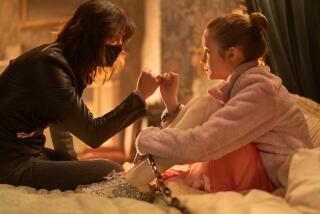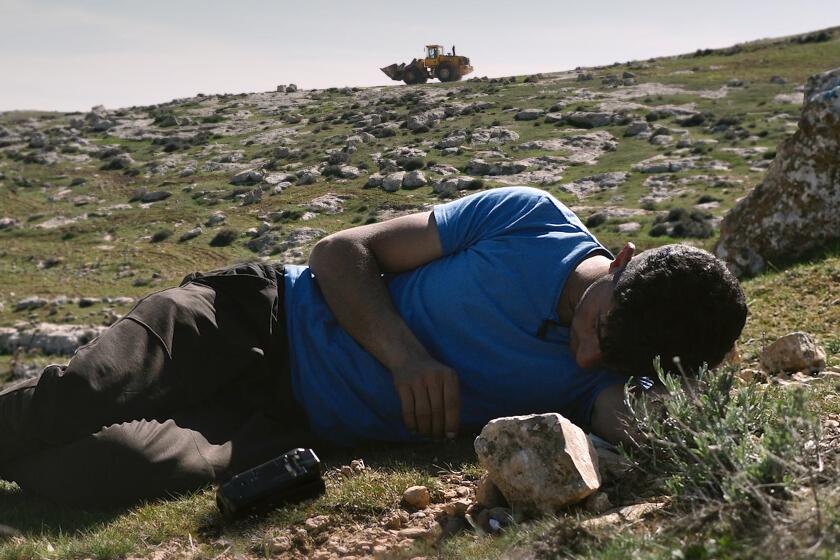Lives Stifled by Mediocrity in ‘Ghost World’
“Ghost World” seems at first like many another teen comedies set during high school’s senior year and focusing on young people at odds with their world and its values. But Terry Zwigoff, director of “Crumb,” the probing documentary about underground cartoonist R. Crumb, and Daniel Clowes, in adapting Clowes’ underground comic book, dig way beneath the surface of suburban America to create a singularly unsettling portrait of a culture in the grip of the mediocre.
Thora Birch, Kevin Spacey’s daughter in “American Beauty,” is Enid, who is ferociously bright and a relentless truth-teller. Enid stands further apart from the other girls, not so much because of her clothes, but because of her paleness and dark-framed oval glasses. By her words and looks, Enid sticks out, but she can take care of herself and has found a staunch friend in Rebecca (Scarlett Johansson), who is very pretty but too smart to go along automatically with the majority.
Enid and Rebecca’s immediate goals are surprisingly modest: graduate and get jobs so they can afford an apartment. But even though she goes through the graduation ceremony, Enid discovers she must stick around to take a summer art course to be a certified high school graduate. Enid is already feeling at a loss, firm in her views about what she doesn’t like and doesn’t want to do but clueless as to what she really wants to do with her life. Her art teacher, Roberta (Illeana Douglas), is an earnest ex-hippie type who worships at the altar of creativity so intensely she gives the impression of not having much herself.
With Enid none too enthralled by her required course, and Rebecca settling into a routine job at a coffee franchise at the mall, the girls are bored and restless enough to pull a cruel joke on a lonely man, Seymour (Steve Buscemi), who has placed an ad in the personals. Enid is startled to realize he’s the same man she buys a record from at his garage sale. Seymour is a thin, unprepossessing 45-year-old loner whose greatest passion in life is collecting rare jazz records. Buscemi rarely has had so full and challenging a role, that of a mature, reflective man, unhandsome yet not unattractive, thanks to a witty sensitivity and clear intelligence.
Up to this point “Ghost World” has proceeded from one sharply observed scene to the next, but the pace is static, a deliberate ploy that effectively plays against the tension that builds as a bond grows between Enid and Seymour. They’re a pair of critical outsiders, the first as tactless and attention-getting as the second is in danger of being overlooked. In the meantime Enid begins learning some of life’s great truths: that situations are continually changing, so that you can’t always depend on the same people, and that you can’t go around speaking your mind without eventually alienating everyone. Enid is on a course headed for nothingness: no friends, no goals, no resources--only an acute sense of all that’s wrong with the world.
Zwigoff and his first-rate crew manage to project forcefully the essentially mediocre world in which Enid lives and which repels her while conventional people seem to fit in it comfortably without much reflection.
Zwigoff’s cameraman, Alfonso Beato, and production designer, Edward T. McAvoy, become major players creating this world, which unfolds in L.A.-area streets lined with attractive ‘40s and ‘50s apartment houses. Enid and her kindly, diffident single father (Bob Balaban) and Seymour live in meticulously retro units, all in warm earth tones with ‘50s-’60s decor. Both homes project a sense of security but also drabness, although Seymour’s home is far more personal, revealing him to be a tasteful, discriminating collector, not only of records but vintage posters and other artifacts. Beato and McAvoy set up a sharp contrast between these interiors along gracious older neighborhood streets and the glary, hard-edged world of the mall.
A poster in Seymour’s collection proves pivotal in Enid’s destiny, inadvertently exposing her to the full destructive force of conventional wisdom. “Ghost World” is often very funny, with a satirical edge sustained by one and all. The cast includes Stacey Travis as an attractive, confident real estate agent eager for romance but ill-matched with Seymour. As its title suggests, “Ghost World” is above all a disquieting consciousness-raiser about how the world around us is changing, often simply disintegrating, so rapidly it seems but a ghost of its former self.
MPAA rating: R, for strong language and some sexual content. Times guidelines: Language, adult themes and situations.
Ghost World
Thora Birch: Enid
Scarlett Johansson: Rebecca
Steve Buscemi: Seymour
Brad Renfro: Josh
Illeana Douglas: Roberta
Bob Balaban: Enid’s Dad
Stacey Travis: Dana A United Artists Films and Granada Film in association with Jersey Shore and Advanced Medien presentation of a Mr. Mudd production. Director Terry Zwigoff. Producers Lianne Halfon, John Malkovich, Russell Smith. Executive producers Pippa Cross, Janette Day. Screenplay by Daniel Clowes and Zwigoff; based on the comic book by Clowes. Cinematographer Alfonso Beato. Editors Carole Kravetz-Aykanian, Michael R. Miller. Music David Kitay. Costumes Mary Zophres. Production designer Edward T. McAvoy. Art director Alan E. Muraoka. Set decorator Lisa Fischer. Running time: 1 hour, 34 minutes.
Exclusively at the Sunset 5, 8000 Sunset Blvd., West Hollywood, (323) 848-3500; and the Westside Pavilion Cinemas, 10800 W. Pico Blvd., West Los Angeles, (310) 475-0202.
More to Read
Only good movies
Get the Indie Focus newsletter, Mark Olsen's weekly guide to the world of cinema.
You may occasionally receive promotional content from the Los Angeles Times.








